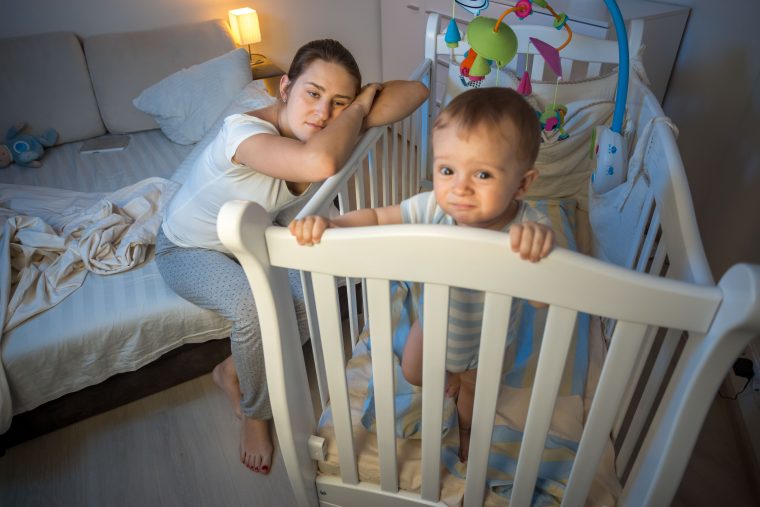If your baby has suddenly started resisting naps, you’re not alone. As a mother of two and a long-time pediatric sleep consultant, I can attest to the fact that sleep needs are constantly evolving as our children grow. As a result, it’s very common to go through periods where your child stops going down for naps like they’ve been accustomed to doing. In fact, in the past 6 months, 43% of families with children past the newborn stage have sought help from HuckIeberry for their child’s sudden nap resistance. Is it challenging when your baby fights sleep? Um, yeah! Are there ways you can help your baby nap easily again? Absolutely!
Here are 4 reasons why babies start resisting day sleep, and what you can do about it:
1. Your child is ready for a nap transition
Babies will often start regularly fighting day sleep when they’re ready to drop a nap. Since children go through many nap transitions in their first two years of life, here’s a handy cheat sheet of what you can expect –
- By 3-4 months they’re often down to 4 naps
- By 5-6 months they’re usually taking 3 naps
- By 7-9 months they’ve dropped down to 2 naps
- By 14-18 months they’re ready for just one nap per day
If your child is near an age when there’s typically a nap transition, consider whether you need to adjust their schedule for easier napping.
2. Insufficient sleep pressure
While night sleep is controlled in part by circadian rhythm, naps are primarily controlled by “sleep pressure.” Sleep pressure (or the homeostatic sleep drive) builds throughout a baby’s awake periods during the day. If the awake period is too short for the child, they’ll be “under tired” and have difficulty falling asleep.
Finding the right wake window before each nap can be tricky. As babies grow, so will their awake periods. Additionally, the right amount of awake time tends to lengthen throughout the day. Typically the shortest window of awake time is before the first nap and the longest window is before bed. Since overtiredness (staying awake beyond the appropriate wake window) can also lead to difficulty falling asleep and staying asleep, determining the best wake periods can cut down on a lot of sleep challenges. Luckily, Huckleberry’s taken the guesswork out of finding the best nap times with our SweetSpot® nap predictor.
3. The sleep space is too distracting
Do you sleep better in a dark, quiet room or a bright and noisy one? Once a baby is out of the newborn stage, they tend to sleep better in a dark, quiet room too. Take a look at your child’s sleep environment. Is it too bright? Can household or neighborhood sounds be easily heard? Are there exciting toys within reach? If so, consider revamping the sleep space with blackout curtains to darken the room and a white noise machine to muffle sounds. The AAP recommends that white noise machines should not exceed 50 decibels, which is the current recommended noise limit for infants in hospital nurseries.
It’s common for parents to avoid darkening the room and using white noise because they worry that their child will need these measures forever and will no longer be able to sleep if there’s any noise or light. The fact is that humans just sleep better in a dark, cool environment without sudden noises. So it’s better to just give your child an environment that they’ll sleep better in. Some kids just naturally wake easier than others. Also, keep in mind that it’s not forever; children usually transition just fine to sleep at daycare where it is not pitch black or quiet because the “peer pressure” of seeing all of the other children sleep helps.
4. They need a routine to help cue that it’s nap time
Nap routines are often overlooked, but quite important. After all, we can’t expect children to go from an engaging activity straight to sleep without any wind-down time. Consistent pre-sleep routines can make a big difference in how easily a child falls asleep. They can help children transition from playtime to sleep time by lowering the heart rate and providing a cue that it’s time to sleep. Routines also bring a sense of security by helping the child understand what to expect next – sleep!
If you don’t already have a nap routine in place, choose a few activities that you can regularly do before each nap. For instance, you might take 10 minutes before each nap to: change your baby’s diaper, put on a sleep sack, read a book, sing a song, and then lay them down to sleep with some key words like, “Sleep well, I love you!” It doesn’t matter what the steps are, as long as they are calm and consistent.
Bonus tip: If your little nap fighter ends up skipping a nap altogether, it can be a good idea to offer an earlier bedtime to limit overtiredness…
About the Author:
Amber LoRe is a pediatric sleep consultant with Huckleberry. She’s always considered herself an advocate for children – from early jobs in daycare to her work as a family law attorney. She’s been helping families get more sleep since 2011 and never gets tired of hearing success stories from happy clients. Amber lives outside NYC with her husband, their two awesome children, and their rescue pup.
Huckleberry was created to make sleep consultations for children more affordable for families. At Huckleberry, parents can find the help they need to tackle night wakings, achieve an easier bedtime, get longer and more predictable naps, or sleep in later. Check out the free tools or sign up for advanced analysis and sleep plan.








